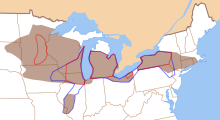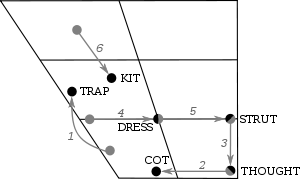- Northern cities vowel shift
-
 Three isoglosses identifying the NCVS. In the brown areas /ʌ/ is more retracted than /ɑ/. The blue line encloses areas in which /ɛ/ is backed. The red line encloses areas in which /æ/ is diphthongized to [eə] even before oral consonants. The areas enclosed by all three lines may be considered the "core" of the NCVS; it is most consistently present in Syracuse, Rochester, Buffalo, Detroit, and Chicago. From Labov et al. 2006: 204. See: Inland Northern American English.
Three isoglosses identifying the NCVS. In the brown areas /ʌ/ is more retracted than /ɑ/. The blue line encloses areas in which /ɛ/ is backed. The red line encloses areas in which /æ/ is diphthongized to [eə] even before oral consonants. The areas enclosed by all three lines may be considered the "core" of the NCVS; it is most consistently present in Syracuse, Rochester, Buffalo, Detroit, and Chicago. From Labov et al. 2006: 204. See: Inland Northern American English.
The Northern cities vowel shift is a chain shift in the sounds of some vowels in the dialect region of American English known as the Inland North.
Contents
Geography
The name of the shift comes from the region where it occurs, a broad swath of the United States around the Great Lakes, beginning some 50 miles (80 km) west of Albany and extending west through Syracuse, Rochester, Buffalo, Cleveland, Detroit, Chicago, Madison, and north to Green Bay; the shift also affects a corridor of cities along Interstate 55 southwest of Chicago as far as St. Louis.[1]
William Labov, a linguist at the University of Pennsylvania, believes that the trend may have started in the early 19th century during the construction of the Erie Canal. Migration of workers from the East Coast to the Great Lakes area brought together speakers of different varieties of English, a situation in which language change can be expected to proceed quickly.[2]
Details
Raising and tensing of /æ/
The first sound change in the shift, which was identified in the Northern states as early as the 1960s by Fasold,[4] was the general raising, tensing, and lengthening of the "short a", that is, the vowel of cat: IPA /æ/. Inland Northern /æ/ comes to be articulated so that the tongue starts from a position that is higher and fronter than it used to be, and then often glides back toward the center of the mouth, thus producing a centering diphthong of the type [ɛə] or [eə] or at its most extreme [ɪə], which is the vowel heard in England in words like pier and beer[citation needed]. Thus cat and that as pronounced by a Rochesterian may sound like "kee-at" and "thee-at" to a visitor.
Fronting of /ɑ/
The raising of /æ/ leaves an empty space in low front position that allows /ɑ/ to be fronted in the direction of [a]. /ɑ/ was the vowel in Great Lakes residents' pronunciation of both cot and father, often called "short o" (or "broad a"). Therefore, /ɑ/ comes to be pronounced farther forward in the mouth, similar to the vowel of car as pronounced in Boston; for some advanced speakers, it may be close or even identical to [æ]—that is, the vowel of cat for speakers without the shift.
Lowering of /ɔ/
The fronting of /ɑ/ leaves a blank space in Northerners' pronunciation that is filled by lowering /ɔ/ (the "aw" vowel, as in saw), which comes to be pronounced with the tongue in a lower position, closer to [ɑ]. As a result, people affected by the shift may pronounce stalk the way speakers without the shift say stock. However, in other regions where such a lowering occurs, it results in the cot–caught merger. The merger does not occur in the Inland North because NCVS speakers front the /ɑ/ phoneme to [a], thus maintaining the distinction between /ɑ/ and /ɔ/. Northerners also typically pronounce "dawn" like "yawn", and "don" like "Ron", while others generally pronounce both "dawn" and "don" as in "Ron".
Backing and lowering of /ɛ/
The first stage, æ-tensing, resulted in a vowel that sounded confusingly like [ɛ], similar to the "short e" in bet. To "get out of the way" of /æ/[original research?], Northern /ɛ/ moves in the direction of [ɐ], the near-open central vowel. As the vowel [ɐ] is pronounced with the tongue farther back and lower in the mouth than in the sound [ɛ], this change is called "backing and lowering".
Backing of /ʌ/
The next change is the movement of /ʌ/ toward [ɔ]. /ʌ/ is the "short u" vowel, as in cut. People with the shift pronounce cut so that it sounds more like caught to people without the shift.
Lowering and backing of /ɪ/
The final change is lowering and backing of /ɪ/, the "short i" vowel, as in bit. This makes it sound more like /ɛ/, although the sounds remain distinct.
Reach
Like most chain shifts, the Northern cities vowel shift is not complete in all areas at the same time: some but not all aspects of the shift can be found further afield. For example, the backing of /ɛ/ is found as far South as St. Louis and as far West as Cedar Rapids, Iowa, and the diphthongization of /æ/ before most consonants is found in parts of Minnesota, such as St. James, Minneapolis-St. Paul, and Brainerd. Accents in which /ʌ/ is more retracted than /ɑ/ are encountered as far East as Providence, Rhode Island, as far South as St. Louis, as far North as Bemidji, Minnesota, and as far West as Aberdeen, South Dakota.[5] The shift is in progress throughout the Great Lakes cities; thus some speakers might have, for instance, the first two stages only, but none have only the last stage.
The shift is mainly found in European American speakers. Speakers of African American Vernacular English show little to no evidence of adopting the shift. It has also not been adopted by Canadian speakers, despite the geographic proximity of millions of Canadians living near the United States border in the Great Lakes region and along the Saint Lawrence River.
See also
Notes
- ^ Labov et al. 187–208.
- ^ Haynie, Devon, "Where'd you learn to speak like thee-at?" Columbia News Service, April 10, 2007, http://jscms.jrn.columbia.edu/cns/2007-04-10/haynie-vowelshift (retrieved on January 28, 2009).
- ^ W. Labov, S. Ash and C. Boberg (1997). "A national map of the regional dialects of American English". Department of Linguistics, University of Pennsylvania. http://www.ling.upenn.edu/phono_atlas/NationalMap/NationalMap.html. Retrieved 10 April 2011.
- ^ Fasold 1969
- ^ Labov et al. 204
References
- Boberg, Charles (2000). "Geolinguistic Diffusion and the U.S.-Canada Border". Language Variation and Change 12:1–24
- Dinkin, Aaron (2007) and William Labov (2007). "Bridging the Gap: Dialect Boundaries and Regional Allegiance in Upstate New York". Paper presented at Penn Linguistics Colloquium 31.
- Gordon, Matthew J. (2001). Small-town Values and Big-city Vowels: A Study of the Northern Cities Shift in Michigan. Durham, N.C.: Duke University Press. ISBN 0-8223-6478-6.
- Labov, William, Sharon Ash, and Charles Boberg (2006). The Atlas of North American English. Berlin: Mouton-de Gruyter. ISBN 3-11-016746-8.
External links
Categories:- North American English
- Culture of Buffalo, New York
- Culture of Milwaukee, Wisconsin
- Culture of Chicago, Illinois
- Culture of Cleveland, Ohio
- Culture of Detroit, Michigan
- Culture of Syracuse, New York
- Vowel shifts
Wikimedia Foundation. 2010.

